6. Episodic Long-Term Memory
1/47
There's no tags or description
Looks like no tags are added yet.
Name | Mastery | Learn | Test | Matching | Spaced |
|---|
No study sessions yet.
48 Terms
Blank
Memory is the most important function of the brain; without it life would be a _____. Our knowledge is all based on memory. Every thought, every action, our very conception of personal identity, is based on memory…Without memory, all experience would be useless.
Edridge-Green, 1900
Squire’s Taxonomy of Long-Term Memories

Explicit memory/declarative memory
__________________ - Long-term memory knowledge that can be retrieved and then reflected on consciously
A.K.A. Declarative Memory
Implicit memory/non-declarative
_______________ - Knowledge that can influence thought and behaviour without any necessary involvement of conscious awareness
A.K.A. Non-declarative Memory
Episodic memory
________________ - Autobiographical memory; stores personally experienced events
E.g., the events you experienced at a fun party
About YOU
Some part of autobiographical memory is semantic like thinking you are a good person– what would it be based on, while interactions with other people.
Interactions (episodic) help develop facts about ourselves (semantic)
Semantic memory
_______________ - Stores general world knowledge, like concepts and categories
E.g., knowing that the capital city of Saskatchewan is Regina
Some part of autobiographical memory is semantic like thinking you are a good person– what would it be based on, while interactions with other people.
Interactions (episodic) help develop facts about ourselves (semantic)
Mnemonic
Preliminary issues
_______________ - An active, strategic learning device or method
E.g., “The Knuckle Mnemonic” for days in a month
Acronyms, songs…
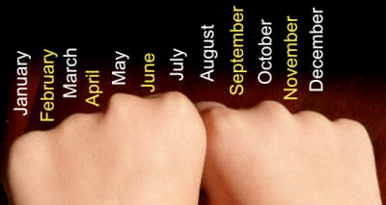
Strengths of Mnemonics
Preliminary issues → mnemonic devices
The material to be remembered is practiced repeatedly
The material is integrated into an existing memory framework
The mnemonic provides a way to retrieve the material
Method of Loci
Mnemonics
_________________ - uses known locations as cues for memory items
Based on visual imagery
Two Steps:
Choose a known set of locations
Form a mental image of each thing you want to remember and place it in a location
When it’s time to recall, go through the locations
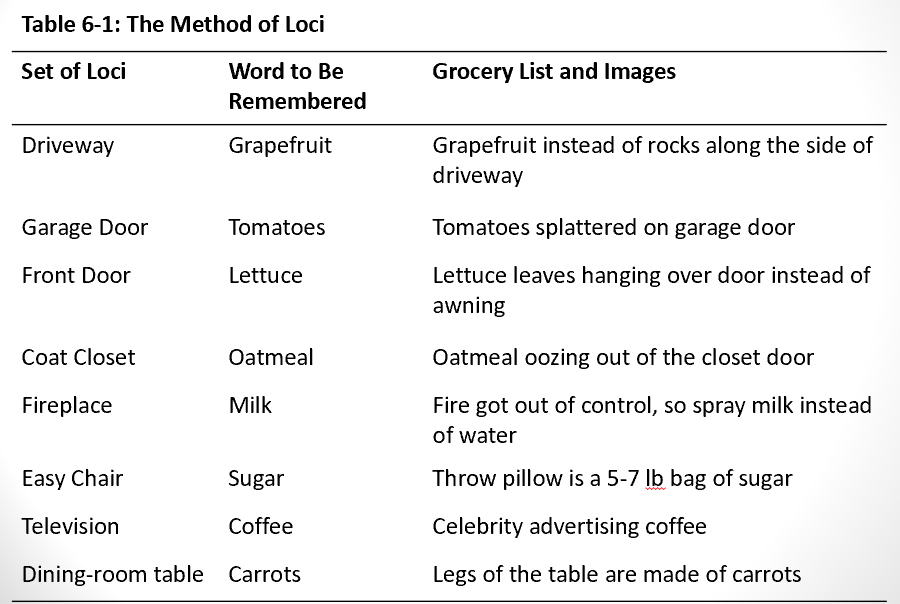
The Peg-Word Technique
Mnemonics
______________ - a pre-memorized set of words serves as a sequence of mental “pegs” onto which the to-be-remembered material can be “hung.”
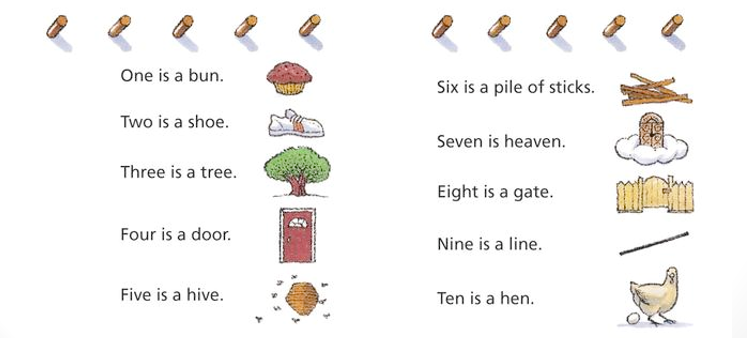
Mnemonic principles
Mnemonics
_____________ -
Provide a structure for learning
Form durable and distinctive memory traces
By means of visual images and rhymes
Guide retrieval by providing effective cues for recalling the information
Three-Step Sequence for learning and memory:
Encoding, retention, retrieval.
Herman Ebbinghaus
______________ - Founder of scientific research on memory
Memory: A Contribution to Experimental Psychology (1885)
Studied his own memory
Used himself as the only participant in his studies
Studied memory using nonsense syllables
Used the relearning task and savings scores
Forgetting curve AKA retention curve— not a massive decrease, more like a flatline
Other Results:
Evidence of Overlearning:
More frequently repeated list = twice the savings score
Longer lists were remembered better
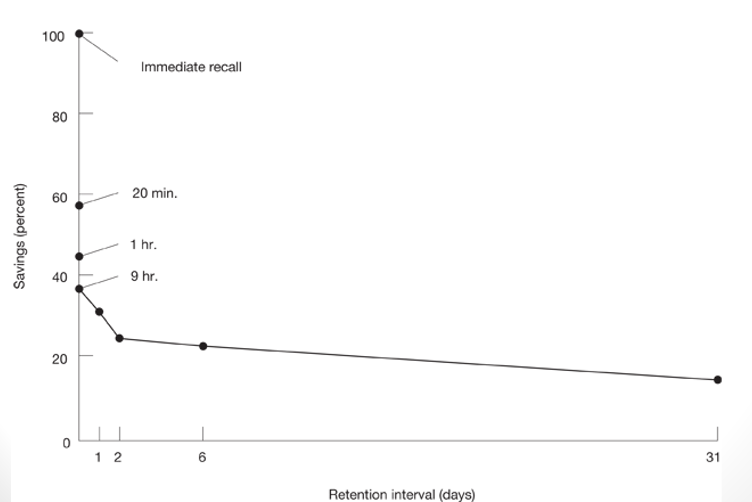
Distributed practice
An important memory effect
_______________ - study time is spread out over many, shorter sessions
E.g., going to all your classes
Massed practice
An important memory effect
_______________ - study time is grouped together into one long session
E.g., cramming before an exam
Metamemory
____________ - Knowledge about one’s own memory, including how it works and how it fails to work
Mnemonics
Judgments of Learning
Metacognition
Metacognition
Metamemory
________________ - Knowledge about one’s own cognitive system and its functioning
Isolation effect
Stages in episodic memory (getting info into the memory system)
_______________ - better memory for information that is distinct from the information around it
A.K.A. von Restorff effect
E.g., printing one word in red when all others are in black
Important principles: rehearsal, organization, imagery
Principles of storage
____________________ - 3 Principles/stages in episodic memory (getting info into the memory system)
Rehearsal
Organization
Imagery
1) Rehearsal
Stages in episodic memory (getting info into the memory system) → principles of storage in episodic memory
_________________ - A deliberate recycling of STM’s contents— A deliberate recycling or practicing of information in the short-term store.
Rundus (1971)
Participants learned 20-item lists of words
5 Seconds/word
People were told to rehearse words aloud, but could rehearse any word that they wanted
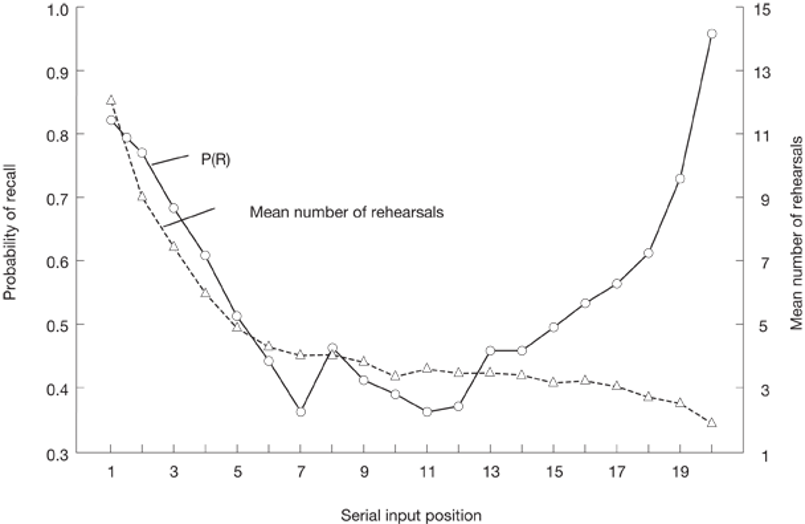
Maintenance rehearsal
…Rehearsal (Craik and Lockhart - 1972)
______________ - A low-level, repetitive information recycling
E.g., holding the number for the pizza restaurant in memory until you dial it
Elaborative rehearsal
…Rehearsal (Craik and Lockhart - 1972)
______________ - A more complex rehearsal using the meaning of the information to store and remember it
Depth of processing
..Rehearsal (Craik and Lockhart - 1972)
_______________ - Memory is determined not by how long information stays in the system, but by how the person processes it
Shallow processing
Deep processing
Shallow processing
…Rehearsal (Craik and Lockhart - 1972) → Depth of processing
___________________ - Leads to poor LTM traces
Used in maintenance rehearsal
Deep processing
…Rehearsal (Craik and Lockhart - 1972) → Depth of processing
_____________ - Leads to strong LTM traces
Used in elaborative rehearsal
2) Organization
Stages in episodic memory (getting info into the memory system) → principles of storage in episodic memory
_________________ - The structuring or restructuring of information as it is being stored in memory
E.g., Bousfield (1953): 60 items for free recall- recalled based on semantic categories
Animals, names, vegetables, and professions
Bower et al. (1969): Participants would see a hierarchy and then try to remember– other group had a similar physical structure but they were randomly organized, so no proper structure
Two Conditions: Organized Condition & Control
Organized: Got organized lists with headers
Control: Same physical structure of lists, but randomized words
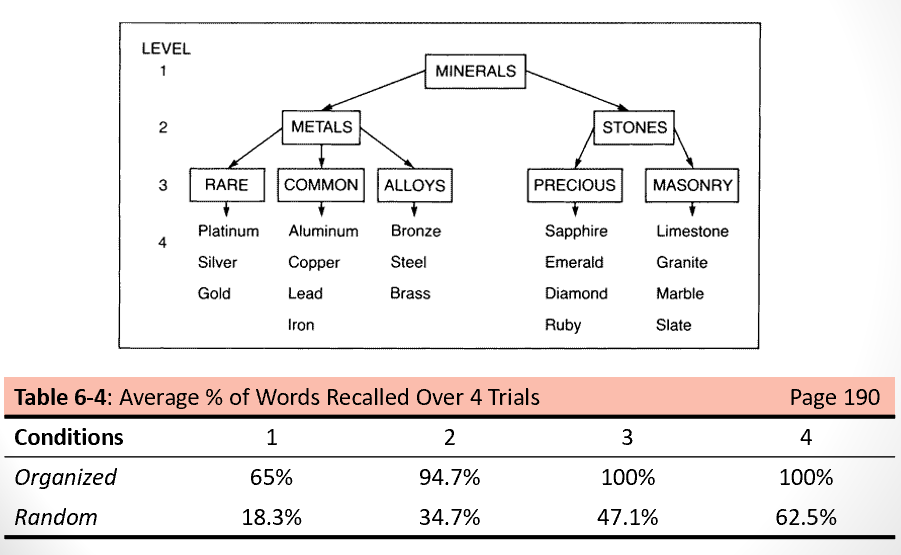
Subjective organization
…Organization
_______________ - Organization developed by a person for structuring and remembering information
Organization developed by the participant for structuring and remembering a list of items without experimenter-supplied categories
3) Imagery
Stages in episodic memory (getting info into the memory system) → principles of storage in episodic memory
_______________ - The mental picturing of a stimulus that affects later recall or recognition
Paivio (1971): Reviewed studies on mental imagery and found a beneficial effects for memory
Dual Coding Hypothesis
Schnorr & Atkinson (1969)
Paired Associate Task
Paired associate task
…Imagery (Schnorr & Atkinson - 1969) → paired associate learning
_______________ - lists of word pairs are presented to a person. After the first presentation, the first word (the stimulus) should act as a cue for the second to-be-produced word (the paired associate response).
E.g. Dog-Book
Dual Coding Hypothesis
…Imagery (Pavio - 1971)
________________ - words that denote concrete objects, as opposed to abstract words, can be encoded into memory twice
Once verbally and again as an image (imaginal attributes)
Concrete Words can be stored twice in long-term memory, once as a word and again as a picture
Example: Elephant → Image of elephant
Abstract Words are only stored once
E.g., justice, idea

Encoding specificity
…Imagery **ON EXAM**
______________ - Each item is encoded into a richer memory representation that includes the context it was in during encoding
Extra information that was present during encoding of an item is also stored
Anything present during learning a target can serve as an effective cue for later remembering that target.
State-dependent learning
E.g., Goodwin et al. (1969)•Each item is encoded into a richer memory representation that includes the context it was in during encoding
If you’re really relaxed studying, you’re not gonna be so relaxed in the exam room, so if you add some stress while practicing, more similar situations can help recall
Ex: Scuba divers remember info better on land than they did when tested underwater because of the stimuli around them
Decay
Retrieving episodic info
____________ - The older a memory trace is, the more likely it has been forgotten
It has decayed away, just like the print on an old newspaper fades and is no longer legible
Thorndike (1914): The law of disuse
Interference causes forgetting - Easier to demonstrate interference instead of decay because decay is the absence of experiences
Paired associate learning
Studying interference in LTM
_____________ - A list of stimulus terms is paired, item by item, with a list of response terms
After learning, the stimulus terms are used as cues for the response terms.
Often used to study proactive and retroactive interference
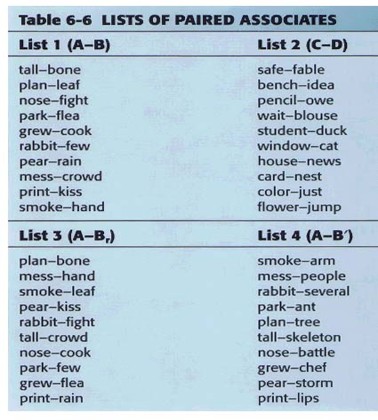
Retrieval failure
________________ - AKA forgetting— When a memory is lost in the system, as opposed to from the system
Ex: Tip of Tongue States
Tip of the Tongue States
Retrieval failure
________________ - When a person is temporarily unable to remember some shred of information (e.g., a name) that they know is stored in LTM
Availability
_______________ - The memory trace exists; it was encoded into LTM
Once encoded, information stays in LTM indefinitely
Accessibility
________________ - Degree to which the memory trace can be retrieved from memory
Information is in LTM, but may or may not be accessed
Retrieval cues
Retrieval failure
___________________ - Retrieval failure occurs when the information is available, but not accessible— which is why we need THIS to help
Recall often underestimates the amount of information that was learned
Retrieval cues can help restore the original learning context
Recall and retrieval are NOT the same— while "recall" is a type of retrieval, "retrieval" is the broader process of accessing information from memory, encompassing both recall and recognition.
Amnesia
_______________ - Loss of memory or memory abilities due to brain damage or disease
Retrograde amnesia
Ribot’s Law- temporal gradient
Anterograde amnesia
Retrograde amnesia
Amnesia
______________ - Loss of memory of events before the injury
Ribot’s Law
Temporal gradient
Ribot’s Law
Amnesia → retrograde amnesia
_____________ - temporal gradient in retrograde amnesia
Temporal gradient
Amnesia → retrograde amnesia → Ribot’s Law
______________ - memories more distant from the time of the amnesia are clearer– the closer memories are to the injury the more likely they are to forget it, but they could remember early childhood things fine
Dissociation
________________ - A disruption in one component of cognition but no impairment of another
Double dissociations represent stronger evidence for functional and anatomical independence than single dissociations.
Double dissociation
Dissociation
________________ - Finding reciprocal patterns of disruption
In one patient, A is disrupted but B is not
In another patient, B is disrupted but A is not
Double dissociations represent stronger evidence for functional and anatomical independence than single dissociations.
Patient K.C.
Dissociation → patients
_________________ - Episodic memory processes were disrupted, but semantic memory processes were in tact.
Patient H.M.
Dissociation → patients
______________ - Unable to transfer new information to LTM, but able to retrieve already stored memories from LTM
Unable to transfer new information to LTM, but able to retrieve already stored memories from LTM.
This person had particular memory

H.M.’s memory
Dissociation → Patient H.M.
_______________ - Hippocampus was lesioned
Could retrieve already stored memories memories from LTM
STM seemed to be intact
Could not transfer information into LTM, yet implicit learning was possible
Implication: Hippocampus is critical for explicit LTM formation
Implicit memory vs. Explicit memory
______________ - Key distinction: explicit memories are consciously accessible
Repetition Priming
Implicit memory can influence conscious experience
E.g., déjà vu
E.g., Advertisements
Repetition priming
Implicit vs. explicit memory
_______________ - a previous encounter with information facilitates later processing on the same information, even unconsciously